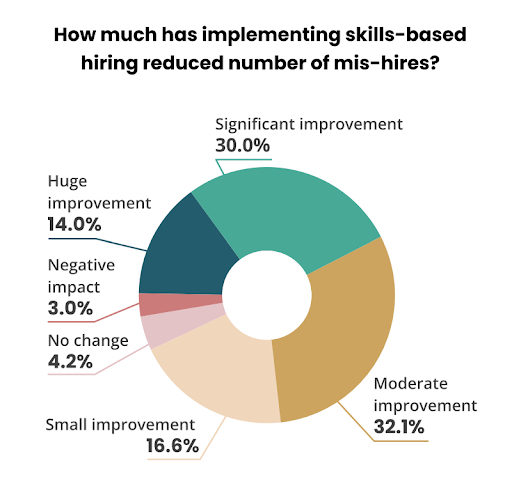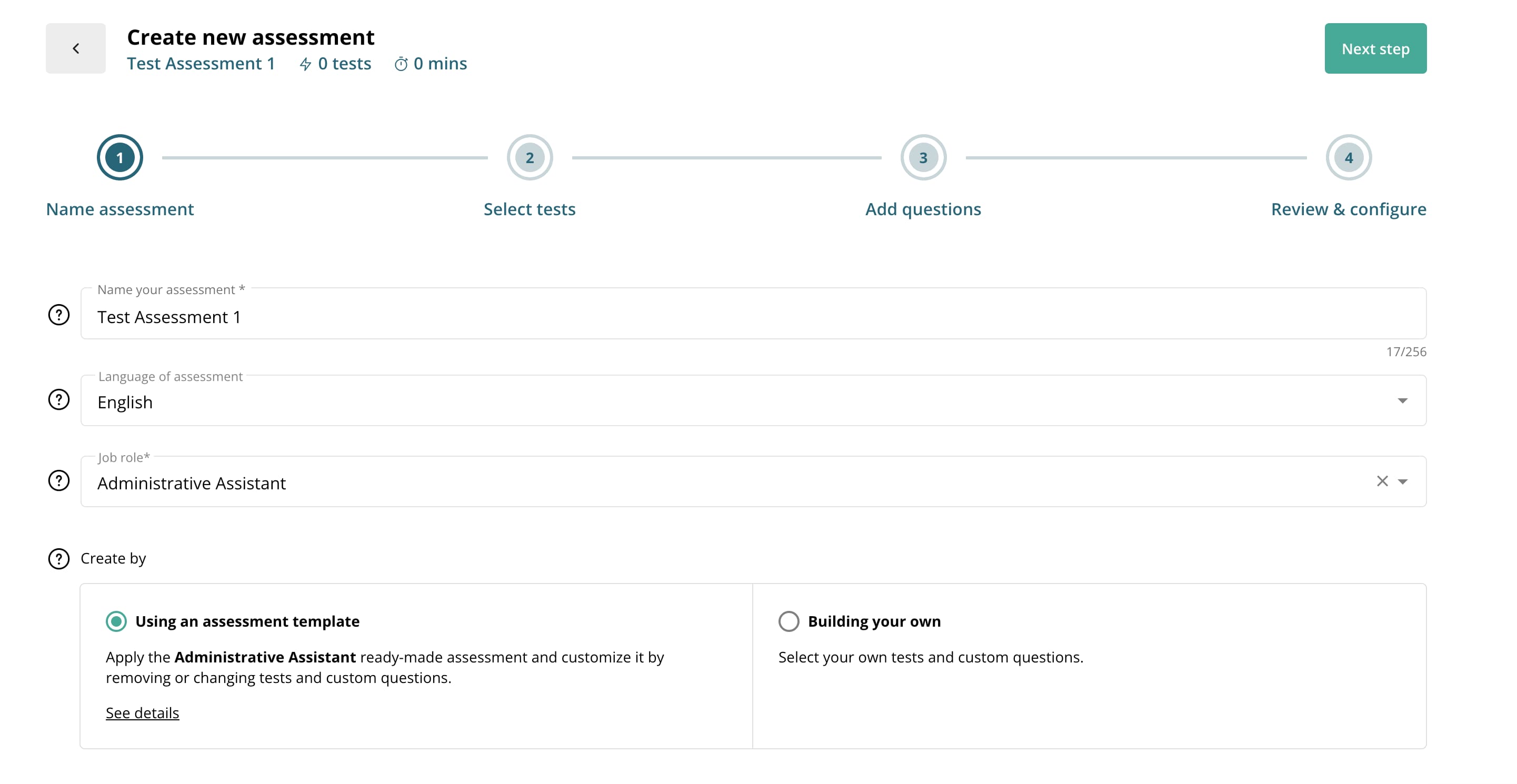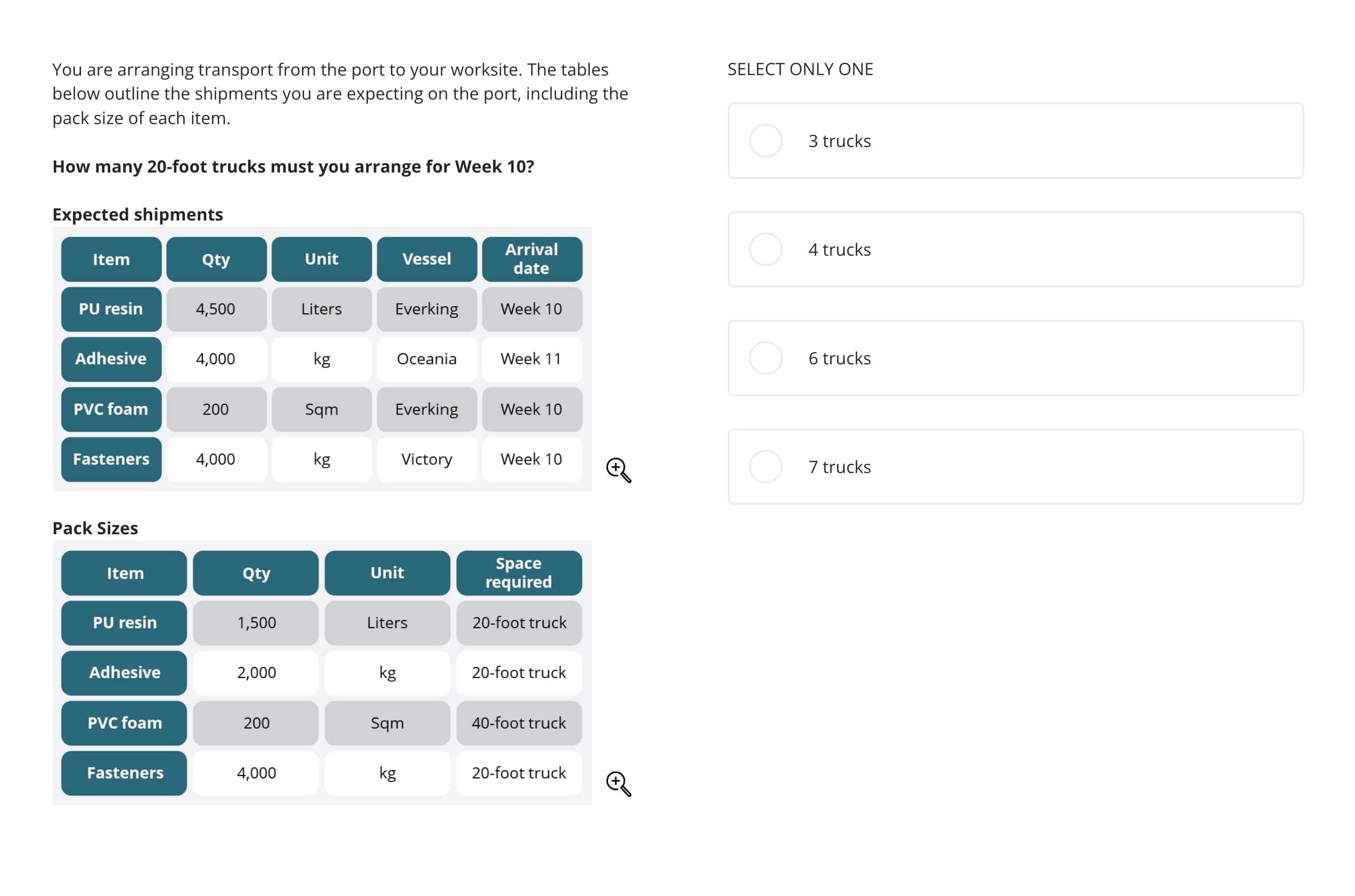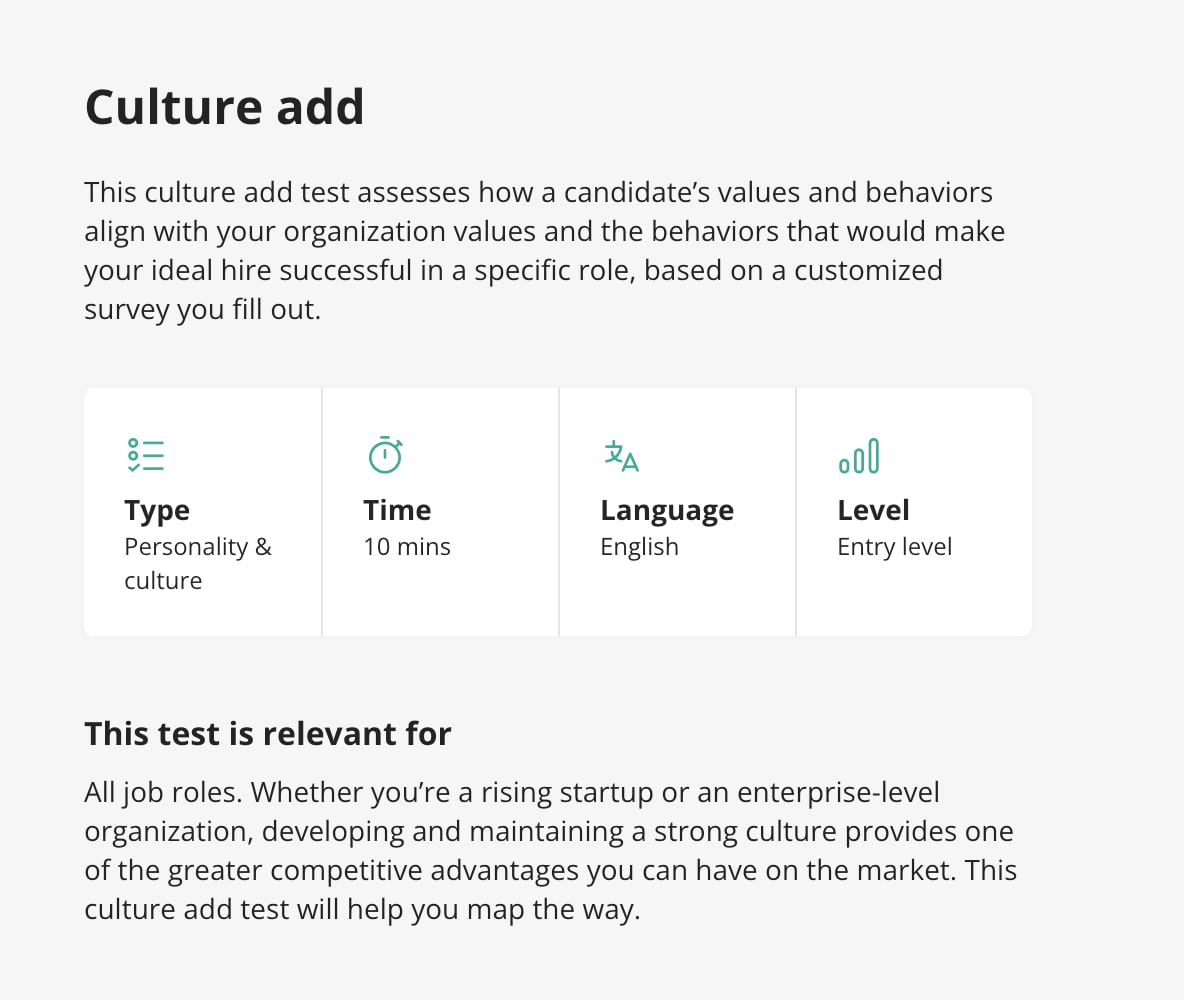High volume hiring is stressful.
When filling a large number of vacancies quickly, you’re still under the usual pressure to vet people for their niche skills, motivation, and whether or not they fit your company culture.
How can you be sure you’re covering all of this accurately? What if you receive more applications than you're expecting?
What’s more, candidates want a personal, proactive recruitment experience. Can hiring managers genuinely offer that if they struggle to give each applicant the attention they deserve?
There’s an answer to all of these worries: talent assessments.
By assessing for skills during high volume recruitment periods, you:
Efficiently and accurately sort applications
Show prospects that you care about their progress
Mitigate bias by relying on objective data
Find staff who stick with you
Hire candidates with the right skills to support your business processes
Let's start by looking at a definition of high volume hiring and the difficulties HR professionals face before we deep dive into how talent assessments help you optimize this process.
Table of contents
In these cases, high volume recruiting is efficient and helps to fill open roles within weeks rather than months.
Some recruiters prefer high volume recruiting because it helps applicants more easily be engaged. Job seekers are unlikely to hold out for other opportunities if hired soon after applying.
High volume hiring strategies are ideal for the recruiting efforts of entry-level positions. However, given that up to 73% of larger companies prefer high volume recruitment, it’s evidently being used at all levels.
Here's where companies might find managing mass applications difficult. Designing a high volume hiring process requires careful research, employee profiling, and existing resource management.
Even with a carefully mapped process, there are still drawbacks to using high volume recruitment as a base strategy.
The difficulties with high volume recruiting
Although high volume hiring seems attractive from an efficiency standpoint, it’s often tricky to balance in practice.
Candidates don’t want to feel rushed through the hiring process or feel that they’re “just filling seats.” More than 75% of job applicants demand more individual interactions during recruitment than they currently receive.[1]
For many hiring teams in the high volume recruitment process, keeping applicants engaged proves to be an elusive art.
Research shows up to 46% of candidates in mass hiring campaigns leave the application process thanks to a poor experience, while 25% of the same pool of candidates quit out of a lack of interest.[2]
However, there are more potential concerns when adopting a high volume system. Here's a quick breakdown.
Potential difficulty | Explanation |
There’s a poor candidate experience | Qualified candidates feel their applications go nowhere; the lack of personal interaction makes applicants feel their skills don’t matter to the recruiter company |
You miss multiple applications from potentially great hires | Handling too many applications at once could lead to you glossing over great candidates because there's pressure to process as many as possible |
You receive several irrelevant and poor-fitting applications | Hurried job descriptions, unclear roles and responsibilities, and condensed staffing periods might lead to mass resumes from prospects who lack skills or interest in the roles advertised |
You prepare for a revolving-door system | Rushing hiring decisions could lead to higher turnover and a constant chase to refill talent gaps |
It’s difficult to match candidates to the perfect roles | High volume systems focus on quantity over quality in that you only hire to fill for immediate need |
You fall back on biases and inappropriate precedences | Recruiting at high volume and speed prevents you from recruiting with objectivity for fitting skills; it's easy to fall back on default judgments |
You spend a lot of time purely hiring people | While high volume systems are efficient by design, they end up time-consuming because you risk bad hires; the process is tiresome and endless |
You have little time to judge values and culture add | Employing at volume gives you little opportunity to get to know people better; whether or not they fit your culture, team hierarchy, or brand values |
How talent assessments help with high volume hiring
When you introduce talent assessments into high volume recruitment, your company and your candidates will quickly notice the improvement in quality and efficiency.
Here’s why.
Hire quality improves
TestGorilla research shows 92.7% of companies using talent assessments when recruiting reduced mis-hiring. Here’s how the data breaks down:
Skill assessments remove inappropriate applicants at source, instead keeping those who show an aptitude for the roles you hire for. Recruiters then prioritize discussing opportunities with promising recruits and high-potential employees.
Talent assessments aid recruiters in sorting applicants based on test scoring and ranking prospects. There's less risk of losing "perfect fits" in a mass of random applications and otherwise settling for bad hires.
Candidate experiences improve
Candidates want to know you’re a great employer to work for, and creating positive employer branding during recruitment is mutually beneficial for you and your prospects.
Is your onboarding process clear and communicative? Do you offer a straightforward interview process for applicants to follow and then reach out proactively to keep them informed on what happens next?
Building a great experience for applicants improves retention rates and ensures you have a pool of skilled professionals to fill skills gaps.
A "good" candidate experience during recruiting is:
Easy to apply for with clear expectations
Openly communicative
Built around skills and aptitude
Rooted in empathetic hiring practices
Skills assessments during hiring frequently improve the candidate experience. They're engaging, produce quick feedback, and give applicants a clear insight into what a recruiter expects from them.
You're likely to attract suitable candidates who want to work with companies that value their abilities, not just how many boxes they check.
There’s less risk of bias
When employing people purely on experience, education, and other face-value profiling, you risk falling back on precedents and preconceptions. This harms workplace diversity and puts you at risk of staffing from a limited talent pool.
Talent assessing during recruitment ensures you judge applicants fairly and at the same level, such as through their skills.
Blind testing is great for reducing unconscious bias (i.e., unintentional hiring discrimination). It creates cultures around talent rather than privilege and promotes diversity hiring without checking boxes for the sake of doing so.
The end result is you show applicants you prioritize their:
Skills
Passion
Cohesion with your culture and values
Finally, you broaden your talent pool and have a more agile workforce sticking with you for longer.
Consider your process for hiring remote employees, too. The broader your talent pool and selection process, the more access you have to prospects worldwide.
Candidate qualification is automated
Eye-tracking studies claim recruiters spend as little as seven seconds reviewing resumes on average. Let’s look at the reasons behind this from a high value hiring perspective.
Could recruiters and HR professionals spend so little time reviewing resumes because they need more time or resources to assess skills and experience?
It’s possible that recruiters truly know they're assessing poor-quality applications early on. Experienced hiring managers often have a list of easy-to-spot red flags they scan for first. Either way, firmer candidate qualification through talent assessment offers alternative benefits.
Autonomous skill assessments for candidates can record scores based on your choice of measurements. Therefore, you have concrete data to work with and don’t have to pore over endless resumes.
Moving toward skills testing during high volume recruitment is a step away from time-consuming resume evaluation altogether.
Before moving into structured screening interviews, you could test for skills when onboarding, shortlisting those with the highest aptitude scores and closest culture adds.
Hiring becomes more efficient
Referring back to TestGorilla’s study mentioned earlier in this section, 91.4% of companies shifting to skill assessments during recruitment found their time-to-hire rates improved.
Time-to-hire rates across multiple industries in North America tend to fall between a time frame of 21 and 28 days. That's a long time for candidates and recruiters handling high volume applications.[3]
Skills testing helps recruiters streamline talent ranking ahead of scheduling interviews. It's easier to filter out people who don't hit the mark and focus on working with those who show talent in priority areas.
Boosting hiring efficiency reduces the risk of losing highly engaged and qualified prospects from the talent pool. You have less need to keep re-running programs to fill gaps, too.
8 ways to use talent assessments to optimize high volume recruiting strategies
Now we’re clear on why talent assessments are so effective in supporting high volume recruiting systems, let’s consider a few different ways they work well in practice.
A quick rundown
Technique | Explanation |
Sort candidates efficiently | Create an applicant tracking system to help you filter by skills first to find talented hires easily |
Create a positive candidate experience | Ensure candidates know what to expect so talented applicants stay engaged |
Test for hyper-specific roles | Build assessment plans from specific tests to determine technical abilities and power skills |
Match skills to various roles | Test for various skills to help support talent pool management and create a directory of internal hires for future roles |
Hire strong culture adds | Easily find people who resonate with your team and values with culture add tests (and reduce employee turnover) |
Hire candidates who stay with you | Create clear, comprehensive testing plans appealing to engaged talent who want to work with you long-term |
Fill gaps more efficiently and improve scalability | Test for different skills to create 360-degree profiles of staff to move around the business if needed |
Improve hiring and evaluation consistency | Ensure assessments remain fair and equal for all to reduce bias and keep talent pools broad |
1. Sort candidates efficiently
Skills tests are great for showing your most promising prospects – without you digging deep into resumes.
Aim to create a system that enables you to sort skill scoring on a “blind” basis. Sort by skill scoring first, and cut down time typically spent sifting through resumes and cover letters. For example, a CRM (candidate relationship management) system or database could help you manage this data.
Skills scoring helps you discover talent through a more diverse talent pipeline. It’s something Accenture’s Rahul Varma held in high regard. Varma confirms skills testing opened up opportunities for his company to discover more prospects from wider pools.[4]
Talent assessments can process a high number of candidates efficiently and accurately assess applications en masse.
2. Create a positive candidate experience
Candidates want engaging, personalized recruitment experiences. They want to know you value their skills and their experience.
With a customized skills test through TestGorilla, you can design multiple assessment routes for applicants to follow and complete in their own time. Then, you simply provide feedback at each stage of the process.
You can create an assessment with a template or build your own using multiple questions.
Doing so gives your applicants a genuine insight into what you're looking for in the right candidate, too. There's little room for guesswork, and applicants appreciate the clarity you provide.
3. Test for hyper-specific roles
High volume recruiters hiring for niche positions benefit from using hyper-specific role testing as early on in the process as possible.
TestGorilla, for example, helps you create role-specific questionnaires to use alongside personality testing. You can easily design a well-rounded, automated review system free from any guesswork.
Say, you want to build an assessment for transport coordinators. All you need to do is head to our test library, pick the Transport Coordinator test, customize (or add) any questions, and then get started with testing. Here’s what a question for this role might look like to your candidates:
Testing using hyper-specific talent assessments removes the need to hire based on experience during high volume drives.
You have all the data you need to decide who to take through to the next stage. There’s also far less need to dig around for references, saving you even more time.
4. Match skills to various roles
Skills testing during hiring opens up lots of opportunities to extend your talent map beyond the jobs you’re actively recruiting for.
For example, companies like Newell Brands use skills matching via AI to help candidates line up for internal recruitment without manually searching. Doing so helps recruiters and HR professionals find the best fit for a specific opening.[5]
Look carefully at the skills you’d typically demand from professionals in a given role and break them down into tests.
If a candidate scores poorly in one category but well in another, and if they're not an ideal fit for a specific role, you could keep them "on file" for future open positions.
5. Hire strong culture adds
Culture add sometimes gets overlooked during mass recruitment drives. When focusing on hiring high volumes in short periods, you likely drift toward candidate experience.
By employing people blindly without culture add, you risk recruiting people who fit poorly with your values and might leave shortly after joining. You're left back at square one, filling the same gaps.
TestGorilla provides a tailored culture add test to add into a custom or templated talent assessment program per your needs:
Using a culture add test as part of your mass recruiting process helps add objectivity to the process. Finding time to account for objective profiling when processing many applications at once is challenging.
Automated, tailored testing reduces time-to-hire and tells you what you need to know about candidates before interviewing.
6. Hire candidates who stay with you
Blindly hiring staff on volume alone risks building a temporary workforce that only stays with you until they find something more suitable.
Talent assessments help you find highly qualified workers with hyper-specific skills for your roles. They’re easier to retain.
With a custom testing system based on specific role traits, you show prospective hires you genuinely care about what they do and have to offer.
Think about designing an assessment plan including testing for personality traits, culture add, leadership development potential, and power skills.
Candidates get a 360-degree view of what you value in staff and what to expect in terms of development. In return, you build a talent pool with multiple skills that can be promoted internally, saving time and money on future recruitment.
This strategy proves helpful when rehiring former employees because you already know their skill profiles and where they'd be great fits.
7. Fill gaps more efficiently and improve scalability
By employing more valuable people and reducing employee turnover through skills testing, you improve your business’s potential to scale.
Use high volume recruiting strategies and skills testing to find talent you might need months or even years away.
Talent assessments help you find latent skills that might not apply to the role you're hiring for, but they could prove helpful further down the line. With skill assessments, you might hire talented people through high volume intakes and find some who show promise for leadership development.
For example, American Residential Services (ARS) used an assessment system to help perform a skills gap analysis in leadership candidates.[6]
From here, consider transforming your high volume process into a scalability-boosting machine for future corporate growth. Simply prioritize skills testing at the start of the staffing system and create a flexible, reliable leadership development plan.
Even if you don’t hire for the precise skills you require for a specific role immediately, you can still use skills tests in employee training and development by onboarding staff quickly in high volume scenarios and upskilling them later.
8. Improve hiring and evaluation consistency
One of the key benefits of using talent assessments in high volume recruiting is you streamline the hiring process to run automated. You change aspects for specific roles when you need to.
With a custom TestGorilla plan, for example, you could build the foundations of a talent assessment with culture add, business ethics and compliance, and time management tests.
These can remain consistent in all recruitment drives you complete, meaning you simply need to switch out role-specific testing when required.
FedEx, for example, alters skill test templates to fit specific needs. All they need to do is ensure all candidates receive the same standardized questions.[7]
Testing consistency ensures all prospective employees receive the same experiences. There’s less unconscious bias and it’s a huge time-saver. It’s a scalable, evergreen way to ensure your high volume process keeps bringing quality prospects into the pool.
Beyond talent assessments: 3 best practices to remember for high volume hiring
While talent assessments are great for boosting high volume recruitment standards, there are a few other must-dos to keep your process effective and efficient.
Here are three best practices.
1. Automate hiring and screening processes where possible
Using a CRM system is always worthwhile to help manage how applicants progress through testing and interviewing.
Sometimes, you might use automation tools to ensure applicants receive emails or chatbot messages during each process stage, such as when they've completed specific tests.
You could use CRM automation to create calendar events in your schedule, cutting down time on interview admin when you have increasing applications to work through.
While optional, artificial intelligence and recruiting software cut corners in the recruitment process when you’re recruiting in bulk. Up to 63% of recruiters, for example, believe AI proves helpful at automating candidate screening completely.
2. Build a database for talent rediscovery
With or without skills testing, it pays to keep candidate details on file. Constantly re-hiring is costly and time-consuming.
Consider creating a database where you clearly identify applicants' skills and scores while prioritizing the most promising non-hires for future roles.
You could reach out to such candidates as a priority over creating new job postings. If they're already pre-tested, leap ahead to the interview stages and onboard within days.
3. Create authentic value propositions
Before you even start testing and interviewing candidates, you need to develop a clear, exciting, and honest job description template.
Create an appealing employee value proposition, too, that shows your:
Values and ethos
Expectations of eventual employees
Development, upskilling, and reskilling opportunities
Following the above, you reduce the risk of onboarding applicants who slow down the high-volume hiring process and those who leave the company disappointed.
Being honest with your EVP builds you a great reputation as an employer who cares about their people. This strategy could be a driver for top-talent applicants when recruiting in high volumes.
Without clear value propositions in your job board descriptions and EVP, you risk getting flooded by irrelevant applicants who slow your high volume process down. Moreover, a poor EVP turns away up to 65% of applicants.
High volume hiring without the headaches
There are many benefits to high volume hiring. However, it's sometimes easy to fall into the trap of bringing low-quality candidates on board.
Talent assessments are great at keeping your intake quality high while continuing to fill talent gaps quickly.
Managed effectively, using talent assessments during high volume recruitment helps you:
Engage better with potential candidates
Find hires who value exceptional communication
Produce a streamlined, automated onboarding process
Sort applicants by aptitude before interviewing
Cut down on time wasters and bad hires
In the meantime, make sure your high volume recruitment strategy is streamlined and flexible. For example, why not learn more about hiring a contractor for flexible and seasonal work at high volumes? Alternatively, why not hire an intern?
Start building your custom assessment plan by taking a tour of TestGorilla’s test library, too, when you’re ready.
Sources
Sweeney, Megan. (June 16, 2016). “Personal Contacts Lead to Jobs”. American Staffing Association. Retrieved July 21, 2023. https://americanstaffing.net/posts/2016/06/16/personal-contacts-lead-jobs/?siteid=HRTSITE
Laurano, Madeline. (September 2021). “The State of High-Volume Recruitment”. Aptitude Research. Retrieved July 21, 2023. https://www.aptituderesearch.com/wp-content/uploads/2021/09/Apt_Fountain-HighVolume_Report-0821_Final11.pdf
Howden, Daniel. “Average time to hire: key recruiting metrics to track”. Resources for Employers. Retrieved July 21, 2023. https://resources.workable.com/tutorial/time-to-hire-metrics
Lewis, Greg. (February 26, 2018). “The New Way Companies Are Evaluating Candidates' Soft Skills (and Discovering High-Potential Talent)”. LinkedIn Talent Blog. Retrieved July 21, 2023. https://www.linkedin.com/business/talent/blog/talent-acquisition/new-way-companies-are-evaluating-candidates-soft-skills
Blehar, Maggie. (February 16, 2023). “6 Companies Successfully Using AI in Their Recruiting Strategies”. Phenom. Retrieved July 21, 2023. https://www.phenom.com/blog/examples-companies-using-ai-recruiting-platform
“Predicting Success: How ARS Identified High-Performing General Managers to Drive Business Growth”. (2022). MDA Leadership Case Study. Retrieved July 21, 2023. https://mdaleadership.com/wp-content/uploads/2022/11/MDA_CaseStudy_ARS_11-22.pdf
“eSkill Clients”. eSkill Talent Assessment Platform. Retrieved July 21, 2023. https://eskill.com/clients/
Related posts
Hire the best candidates with TestGorilla
Create pre-employment assessments in minutes to screen candidates, save time, and hire the best talent.
Latest posts
The best advice in pre-employment testing, in your inbox.
No spam. Unsubscribe at any time.

Hire the best. No bias. No stress.
Our screening tests identify the best candidates and make your hiring decisions faster, easier, and bias-free.
Free resources
This checklist covers key features you should look for when choosing a skills testing platform
This resource will help you develop an onboarding checklist for new hires.
How to assess your candidates' attention to detail.
Learn how to get human resources certified through HRCI or SHRM.
Learn how you can improve the level of talent at your company.
Learn how CapitalT reduced hiring bias with online skills assessments.
Learn how to make the resume process more efficient and more effective.
Improve your hiring strategy with these 7 critical recruitment metrics.
Learn how Sukhi decreased time spent reviewing resumes by 83%!
Hire more efficiently with these hacks that 99% of recruiters aren't using.
Make a business case for diversity and inclusion initiatives with this data.























